Biography of Red Skelton (July 18, 1913 – September 17, 1997)
If some day you’re not feeling well, you should remember some little thing I have said or done and if it brings a smile to your face or a chuckle to your heart then my purpose as a clown has been fulfilled.”
Red Skelton
Red Skelton, America’s greatest clown (in my humble opinion) has passed away. The great comedian has, thankfully, left a large body of work behind in the form of The Red Skelton Show, movies, songs, radio shows, records, books, paintings, etc. At the bottom of this page you will find many Red Skelton resources.
Biography of Red Skelton
Red’s Childhood
Richard “Red” Bernard Skelton was born in Vincennes, Indiana. His father, Joe, who died two months before his birth, was a former clown with the Hagenbeck & Wallace Circus. Before Red Skelton had turned sixteen, he had also clowned in this same show, and acted, sang, or did stand up comedy in medicine shows, minstrel shows, and on board a river showboat. Years later, Red Skelton wrote the poem “The Circus” in honor of his father.
His mother, left with four boys to raise on her own, worked as a cleaning woman and an elevator operator. She taught her son Red (nicknamed for his bright red hair) to appreciate art and gave him tickets to vaudeville shows. As Red Skelton later said, “Mom used to say I didn’t run away from home. My destiny just caught up with me at an early age.” The person most responsible for Red Skelton’s involvement in the theater, however, was the famous actor and comedian, Ed Wynn.
Wynn came to Vincennes in 1923 to put on a show, and spotted the 10-year-old Red Skelton selling newspapers on the street, to help support his family. Ed Wynn went up to him, bought all his newspapers and invited him to the show. He took Red Skelton backstage where he introduced the slack-jawed Red Skelton to everyone and let him look through the peephole at the audience filing in. Red Skelton fell in love with show business at that moment, which changed his life forever.
On the road
At the age of 15, Red Skelton left home to perform with a travelling medicine show, and went on to perform in showboats, minstrel shows, vaudeville, burlesque, and circuses including the Hagenbeck & Wallace Circus where his father had performed. In 1930, Red Skelton met his first wife, Edna Marie Stillwell, while performing in Kansas City. They married a year later, and she became his partner in vaudeville, as well as manager and writer. Even though they divorced 13 years later, Edna remained his chief writer. Red Skelton stated that Edna was responsible for much of his success, having “brought me up from $50 a week to $7,500 a week.”
After years of preparation in vaudeville, burlesque, dance marathons and virtually every other venue available, Red Skelton made his debut on both radio and Broadway in 1937. The next year, he made his movie debut, Having A Wonderful Time. Red Skelton went on to make over 40 movies for MGM during the 1940’s and 1950’s. In 1945, he married again, to Georgia Davis. This marriage lasted for 28 years, and resulted in the births of his son Richie and his daughter Valentina. Richie, unfortunately, died of leukemia in childhood, a blow that devastated the family.
On the radio
After guest appearances on radio in 1937 on The Rudy Vally Show, Red became a regular on Avalon Time, a radio show sponsored by Avalon cigarettes, where he appeared with his first wife, Edna. Rather than the characters that we know, Red appeared in a series of historical sketches based on his “ancestors” such as Christopher Columbus Skelton.
On October 7, 1941, Red Skelton premiered his own radio show, The Raleigh Cigarette Program, where he introduced some of his most beloved characters – Clem Kadiddlehopper, the slow-witted country bumpkin, Willie Lump-Lump, a drunken sot, Cauliflower McPugg, a punch-drunk boxer, The Mean Widdle Kid, who’s most famous expression, “I Dood It,” became a national slogan, San Fernando Red, a likable rogue and con man, and his famous cross-eyed seagulls, Gertrude and Heathcliff.. He appeared with Ozzie and Harriet Nelson, who later went on to their own successful radio and television series. Red Skelton was drafted in March 1944, and the popular series was discontinued.
This is the Army, Mr. Skelton …
Private Red Skelton was shipped overseas to serve with an Army entertainment unit. He later had a nervous breakdown in Italy, spent three months in an Army hospital and was discharged in September, 1945.On December 4, 1945, The Raleigh Cigarette Program picked up where it had left off with Red Skelton introducing some new characters, including Bolivar Shagnasty and J. Newton Numbskull.
Lurene Tuttle and Verna Felton appeared as Junior’s mother and grandmother. David Forrester and David Rose led the orchestra, featuring the lovely Anita Ellis. The announcers were Pat McGeehan and Rod O’Connor, whose weight became a recurring joke on the series. The series ended May 20, 1949 and Red moved to CBS to continue his radio career.
On to TV
His most famous character, the tramp clown Freddie the Freeloader, awaited the advent of his television show in 1951, on CBS. Red Skelton’s television show finished fourth in the ratings in its’ first year, and became even more popular over time. In 1953, it won the Emmy Award for Best Comedy Show. It later moved from NBC to CBS, and won another Emmy Award in 1961 for Outstanding Writing Achievement. At the end of each episode of his television show, Red Skelton would sign off with “Good night and God bless.: One of his most famous bits on his TV show was Red Skelton’s famous recitation of the American Pledge of Allegiance. In 1970, CBS cancelled the show, due to rising production costs and a desire to appeal to a higher class of advertisers.
Red Skelton was deeply wounded by the cancellation, and never truly overcame the hurt. In 1986, when he accepted the Governor’s Award of the Academy of Television Arts and Sciences at the Emmy Awards Show, after receiving a standing ovation, Red Skelton told the audience, I want to thank you for sitting down, I thought you were pulling a CBS and walking out on me.
The Red Skelton Show returned to NBC in 1970. It was unable to regain its’ former success, and was cancelled in 1971. This ended the second-longest run in television history for a television series. After the end of his television series, Red Skelton returned to performing for live audiences, now at clubs, resorts and casinos. In the early 1980’s, he performed at Carnegie Hall, and several of his live performances are now available as part of the Funny Faces video series.
Red’s personal life
In addition, Red Skelton had nurtured a lifelong interest in painting, with individual paintings fetching in excess of $80,000. He estimated that he earned over $2 million per year from his lithographs of clowns.
Red was also a very generous man. He established the Red Skelton Foundation in Vincennes, Indiana, which cares for needy children. Read a story of Red Skelton’s concern for a sick child for a story about Red, his son Richard who died of leukemia as a child, and how Red Skelton reached out to help another child.
Freddie the Freeloader says
As part of Red Skelton’s Funny Faces video, Red Skelton had this to say about Freddie the Freeloader:
“I get asked all the time; Where did you get the idea for Freddie the Freeloader, and who is Freddie really?
Well, I guess you might say that Freddie the Freeloader is a little bit of you, and a little bit of me, a little bit of all of us, you know.
He’s found out what love means. He knows the value of time. He knows that time is a glutton. We say we don t have time to do this or do that. There s plenty of time. The trick is to apply it. The greatest disease in the world today is procrastination.
And Freddie knows about all these things. And so do you.
He doesn’t ask anybody to provide for him, because it would be taken away from you. He doesn’t ask for equal rights if it’s going to give up some of yours.
And he knows one thing ¦ that patriotism is more powerful than guns.
He’s nice to everybody because he was taught that man is made in God’s image. He’s never met God in person and the next fella just might be him.
I would say that Freddie is a little bit of all of us.”
Red Skelton was inducted into the Clown Hall of Fame in 1989.
Red Skelton died of pneumonia on September 17, 1997, at his home in Rancho Mirage, California, USA.
Bibliography for Red Skelton
Books
- Seeing Red : The Skelton in Hollywood’s Closet, by Wes D. Gehring, Steve Bell
- A recent (published in 2001) biography of Red Skelton, America’s favorite clown. Well-done, well-written, and very enjoyable — recommended reading.
- Red Skelton by Arthur Marx
- An older biography of Red Skelton (published in 1979), somewhat more critical, and not nearly as current as ‘Seeing Red’
- The Great Clowns of American Television, by Karin Adir
- Not limited solely to Red Skelton, but still includes some interesting anecdotes and stories about Red.
Movies
- The Red Skelton Show – Clown Prince Boxed Set
- A collection of Red’s TV show, with selected scenes from 1951 through 1971 — a 7 DVD set
- Red Skelton:Christmas Show
- A collection of some of the special Christmas episodes of Red’s TV show — a personal favorite, including a re-telling of one of O. Henry’s short stories, starring Freddy the Freeloader
- Red Skelton’s Christmas Dinner
- A wonderful story of Freddie the Freeloader, out to enjoy Christmas dinner, running into Vincent Price, Imogene Coca … and trouble!
- Ziegfeld Follies (1946)
- Notable for Red’s “When Television Comes” sketch — otherwise a collection of musical & dance numbers — very nice, if you’re into musicals
- The Fuller Brush Man (1948)
- A straightforward romantic comedy, with Red pursuing the girl amid slapstick humor. Well-done, funny, Red Skelton (though that’s repetitive).
- Neptune’s Daughter (1949)
- Primarily a vehicle for Esther Williams, but with Red scoring much laugh time as part of the mixed-up romance
- Three Little Words (1950)
- A personal favorite, since it stars Red Skelton & Fred Astaire, in a semi-biographical telling of a famous songwriting team. Red is as amusing as ever, but also sings, dances, etc. — quite well.
- Rudolph’s Shiny New Year (1979)
- I really, really dislike virtually any Rankin-Bass holiday production. This sequel to Rudolph the Red-Nosed Reindeer is no exception. Red Skelton does the voice of Father Time & Baby Bear, but still… it’s a Rankin-Bass. If you like it, that’s fine; we all have our different tastes.


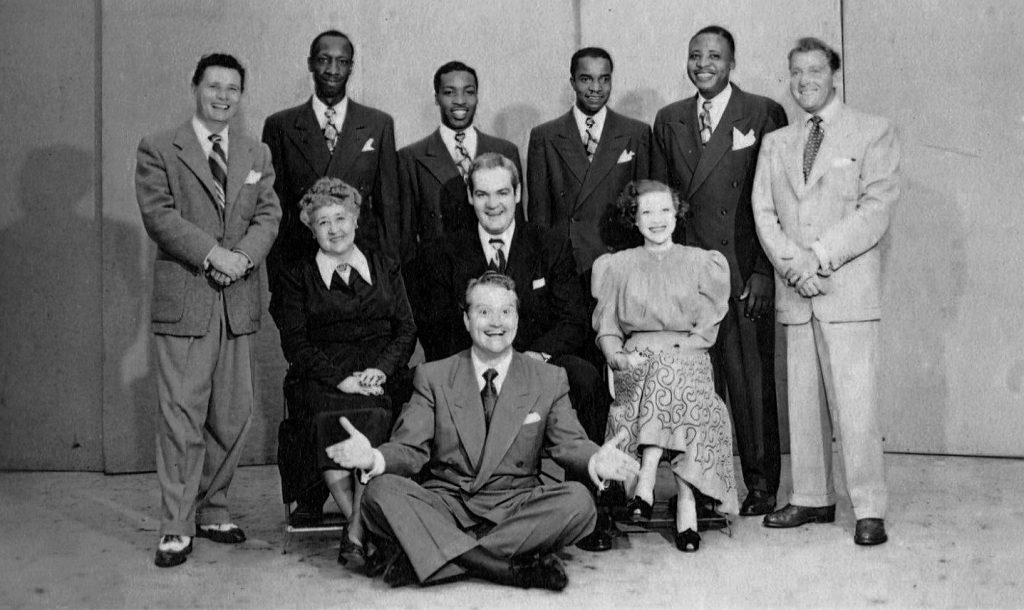
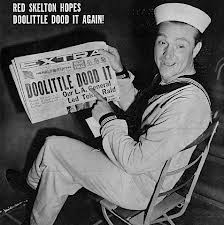
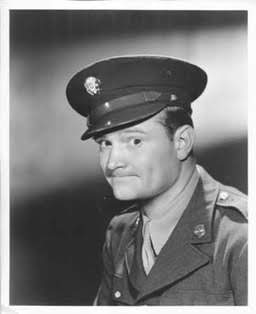
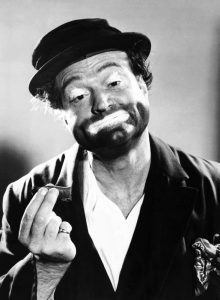
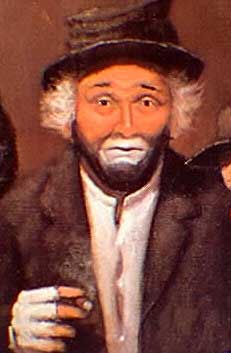
HAPPY BIRTHDAY…RED SKELTON… all the times I think of you a smile still comes on my face…thank you for all those times you made me laugh.. I will never forget you !!! GOD bless YOU…you are still a big part of my life…and you’ll always will be…
Comments are closed.